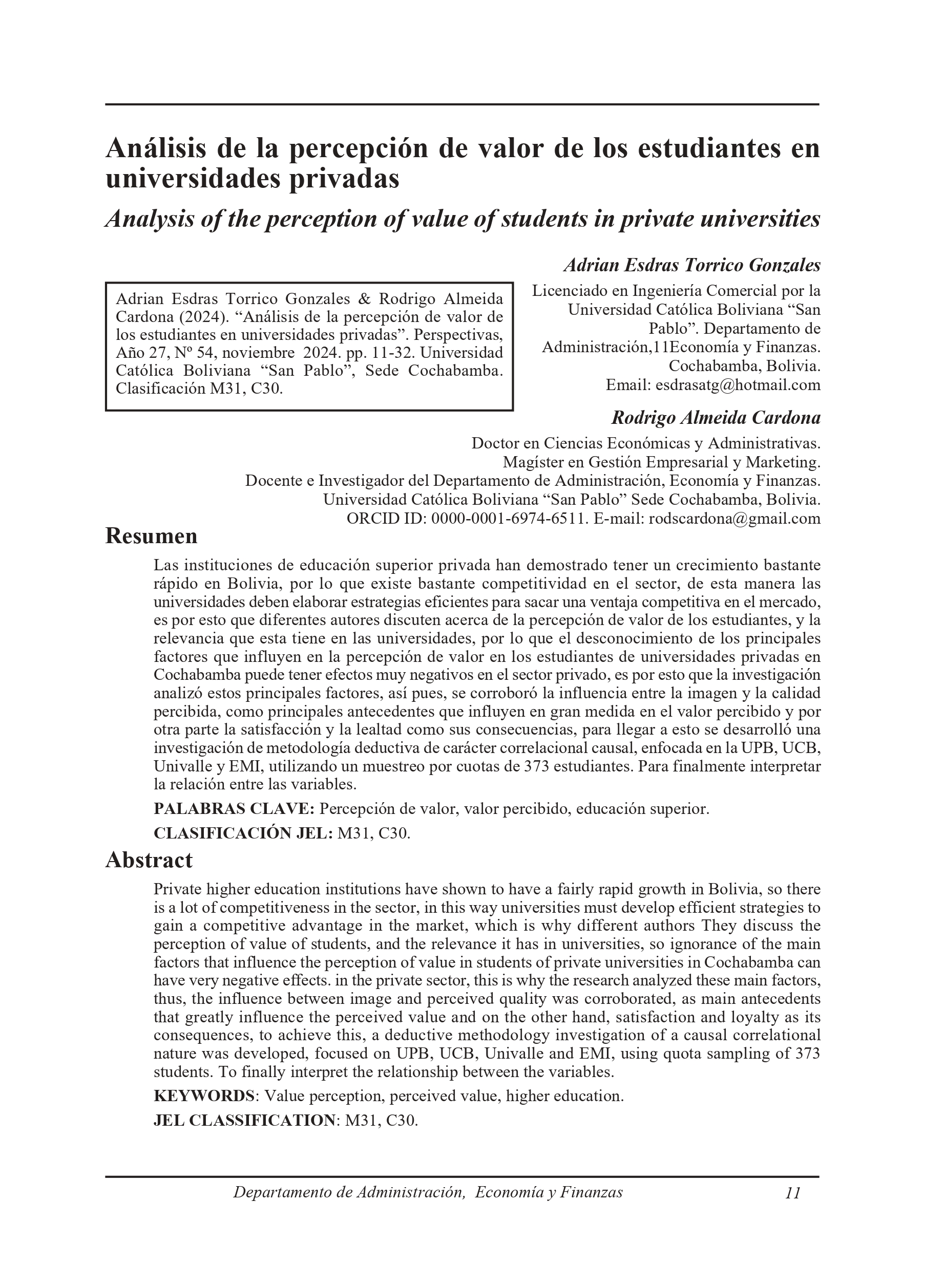Analysis of the perception of value of students in private universities
DOI:
https://doi.org/10.35319/d7jkdf46Keywords:
Value perception, Perceived value, Higher education.Abstract
Private higher education institutions have shown to have a fairly rapid growth in Bolivia, so there is a lot of competitiveness in the sector, in this way universities must develop efficient strategies to gain a competitive advantage in the market, which is why different authors They discuss the perception of value of students, and the relevance it has in universities, so ignorance of the main factors that influence the perception of value in students of private universities in Cochabamba can have very negative effects. in the private sector, this is why the research analyzed these main factors, thus, the influence between image and perceived quality was corroborated, as main antecedents that greatly influence the perceived value and on the other hand, satisfaction and loyalty as its consequences, to achieve this, a deductive methodology investigation of a causal correlational nature was developed, focused on UPB, UCB, Univalle and EMI, using quota sampling of 373 students. To finally interpret the relationship between the variables.
Downloads
References
Alves, H. (2010). Perceived value index in higher education. Marketing, 6, 2.
Alves, H. (2011). The measurement of perceived value in higher education: a unidimensional approach. The Service Industries Journal, 31(12), 1943-1960.
Alves, H., y Raposo, M. (2007). Conceptual model of student satisfaction in higher education. Total Quality Management, 18(5), 571-588.
Barclay, D., Higgins, C., y Thompson, R. (1995). The partial least squares (PLS) approach to casual modeling: personal computer adoption ans use as an Illustration.
Brown, R. M., y Mazzarol, T. W. (2009). The importance of institutional image to student satisfaction and loyalty within higher education. Higher education, 58(1), 81-95.
Carmines, E. G., y Zeller, R. A. (1979). Reliability and validity assessment (Vol. 17). Sage publications.
Cepeda Carrión, G., y Roldán Salgueiro, J. L. (2004). Aplicando en la práctica la técnica PLS en la administración de empresas. In Conocimiento y Competitividad. XIV Congreso Nacional ACEDE. Murcia (pp. 74-8).
Chin, W. W. (1998). The partial least squares approach to structural equation modeling. Modern methods for business research, 295(2), 295-336.
Dijkstra, T. K., y Henseler, J. (2015). Consistent partial least squares path modeling. MIS quarterly, 39(2).
Falk, R. y Miller, N. (1992). A Primer for Soft Modeling. Akron: The University of Akron, 1. ed.
Fornell, C., y Larcker, D. F. (1981). Structural equation models with unobservable variables and measurement error: Algebra and statistics.
Hair Jr, J. F., Hult, G. T. M., Ringle, C., y Sarstedt, M. (2016). A primer on partial least squares structural equation modeling (PLS-SEM). Sage publications.
Henseler, J., Ringle, C. M., y Sarstedt, M. (2015). A new criterion for assessing discriminant validity in variance¬based structural equation modeling. Journal of the academy of marketing science, 43(1), 115-135.
Hermawan, A. (2001). The effects of service cues on perceived service quality, value, satisfaction and word of mouth recommendations in Indonesian university settings. Ph.D. Dissertation, Wayne Huizenga Graduate School of Business and Entrepreneurship, Nova Southeastern University.
Leblanc, G., y Nguyen, N. (1999). Listening to the customer’s voice: examining perceived service value among business college students. International Journal of Educational Management.
Ledden, L., Kalafatis, S. P., y Samouel, P. (2007). The relationship between personal values and perceived value of education. Journal of Business Research, 60(9), 965-974.
Malhotra, N. (2008). Investigación de Mercados (Quinta edición ed.).Ecuador: Pearson Prentice Hall. Recuperado el, 31.
Martensen, A., Grønholdt, L., Eskildsen, J., Kristensen, K. (1999). Measuring student oriented quality in higher education: application of the ECSI methodology. Proceedings from the TQM for Higher Education conference “Higher Education institutions and the issue of total quality”, Verona, 371-383.
McDougall, G. H., y Levesque, T. (2000). Customer satisfaction with services: putting perceived value into the equation. Journal of services marketing.
Nguyen, N., y Leblanc, G. (2001). Corporate image and corporate reputation in customers’ retention decisions in services. Journal of retailing and Consumer Services, 8(4), 227-236.
Nunnally, J. C. (1978). Psychometric theory (2nd ed.). New York: McGraw-Hill
Nunnally, J. C., y Bernstein, I. H. (1994). Psychological theory.
Parasuraman, A. (1997). Reflections on gaining competitive advantage through customer value. Journal of the Academy of marketing Science, 25(2), 154.
Schiffman, L. G., y Lazar Kanuk, L. (2010). Comportamiento del Consumidor (décima edición ed.). Naucalpan de Juárez: Prentice Hall.
Webb, D., y Jagun, A. (1997). Customer care, customer satisfaction, value, loyalty and complaining behavior: validation in a UK university setting. Journal of Consumer Satisfaction, Dissatisfaction and Complaining Behavior, 10, 139-151.
Wong, KKK (2013). Técnicas de modelado de ecuaciones estructurales de mínimos cuadrados parciales (PLS¬SEM) utilizando SmartPLS. Boletín de marketing, 24 (1), 1-32.
Woodruff, R. B. (1997). Customer value: the next source for competitive advantage. Journal of the academy of marketing science, 25(2), 139.
Yang, Z., y Peterson, R. T. (2004). Customer perceived value, satisfaction, and loyalty: The role of switching costs. Psychology & marketing, 21(10), 799-822.
Zeithaml, V. A. (1988). Consumer perceptions of price, quality, and value: a means-end model and synthesis of evidence. Journal of marketing, 52(3), 2-22.

Downloads
Published
Issue
Section
License
Copyright (c) 2024 Revista Perspectivas

This work is licensed under a Creative Commons Attribution-NonCommercial-ShareAlike 4.0 International License.
La Revista Perspectivas de la Universidad Católica Boliviana, es una revista de acceso abierto, por lo tanto, es de libre acceso en su integridad. Está permitida su lectura, búsqueda, descarga, distribución y reutilización legal en cualquier tipo de soporte únicamente para fines no comerciales, siempre y cuando la obra sea debidamente citada.




